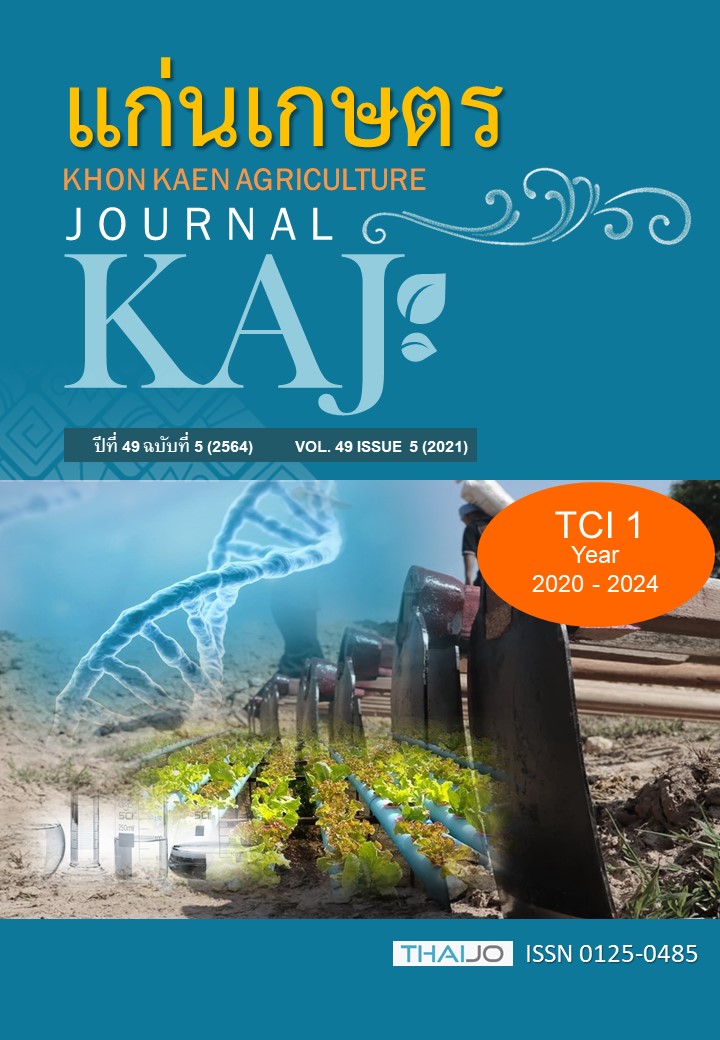การกระจายตัวและการระบุชนิดไส้เดือนฝอยรากปมในพื้นที่เพาะปลูกข้าวจังหวัดปทุมธานี ประเทศไทย
Main Article Content
บทคัดย่อ
ไส้เดือนฝอยรากปม Meloidogyne spp. มีการรายงานในหลายประเทศถึงการแพร่ระบาดในแปลงปลูกข้าว ซึ่งการพบไส้เดือนฝอยรากปมจำนวนมากในแปลงข้าวอาจนำไปสู่ความเสียหายของผลผลิตได้ ดังนั้นงานวิจัยนี้มีวัตถุประสงค์เพื่อสำรวจปริมาณ และระบุชนิดไส้เดือนฝอยรากปมที่พบในแปลงข้าวจังหวัดปทุมธานี จาก 6 อำเภอ ได้แก่ หนองเสือ ลำลูกกา ธัญบุรี คลองหลวง อำเภอเมือง และสามโคก โดยรอยย่นที่ก้น (perineal pattern) ที่พบในทุกอำเภอมีลักษณะเป็นวงรี ผิวหนังเรียบ และไม่มี lateral lines ซึ่งคล้ายกับ Meloidogyne graminicola และจากการตรวจสอบปริมาณการแยกไส้เดือนฝอยรากปมในดินโดยวิธี Christie and Perry technique พบว่าอำเภอเมืองมีจำนวนมากที่สุด (8.3 ตัว/150 กรัม) ส่วนในรากข้าวโดยวิธี Extraction Tray Method พบว่าอำเภอสามโคกพบมากที่สุด (70.6 ตัว/10 กรัม) ในข้าวพันธุ์ปทุมธานี 1 อย่างมีนัยสำคัญ (P≤0.05) ซึ่งพบว่าลักษณะสัณฐานวิทยาของตัวอ่อนระยะที่ 2 มีความยาวลำตัวเท่ากับ 427–501 ไมโครเมตร stylet มีความยาวเท่ากับ 13–15 ไมโครเมตร บริเวณหางเป็นรูปกรวย (conoid) รวมถึงจัดจำแนกเพื่อยืนยันชนิดของไส้เดือนฝอยรากปมด้วยเทคนิคทางอณูชีววิทยาด้วยวิธี polymerase chain reaction (PCR) โดยไพรเมอร์จำนวน 3 คู่ ได้แก่ rDNA2/rDNA1.58s, C2F3/1108 และ SCAR-MgFW/SCAR-MgRev พบว่ามีขนาดดีเอ็นเอเท่ากับ 490, 520 และ 650 คู่เบส ตามลำดับ และนำผลมาวิเคราะห์แผนภูมิความสัมพันธ์ทางวิวัฒนาการบริเวณยีน 18S-ITS1-5.8S ชี้ให้เห็นว่าไส้เดือนฝอยรากปมที่พบคือ M. graminicola ที่มีความเหมือนกับไส้เดือนฝอยรากปมข้าวจากประเทศเวียดนามมากกว่า 98 เปอร์เซ็นต์ ดังนั้นไส้เดือนฝอยรากปมที่พบในแปลงข้าวจังหวัดปทุมธานี คือ M. graminicola
Article Details

อนุญาตภายใต้เงื่อนไข Creative Commons Attribution-NonCommercial-NoDerivatives 4.0 International License.
เอกสารอ้างอิง
กนกทิพย์ ทะลือ, บัญชา ชิณศรี, อนงค์นุช สาสนรักกิจ และธานี ศรีวงศ์ชัย. 2562. การศึกษาลักษณะทางสัณฐานวิทยา การจําแนกชนิด และความสามารถในการก่อให้เกิดโรคของ Meloidogyne graminicola ที่พบในพื้นที่ต่าง ๆ. น. 723–730. ใน: การประชุมวิชาการเสนอผลงานวิจัยระดับบัณฑิตศึกษาแห่งชาติครั้งที่ 20 วันที่ 15 มีนาคม 2562. บัณฑิตวิทยาลัยมหาวิทยาลัยขอนแก่น, ขอนแก่น.
กิตติพงษ์ ศรีม่วง และพรทิพย์ เรือนปานันท์. 2562. ไส้เดือนฝอยศัตรูข้าวที่ต้องเฝ้าระวังในจังหวัดนครนายก. น. 138–145. ใน: ประชุมวิชาการข้าวและธัญพืชเมืองหนาวครั้งที่ 36 วันที่ 12-15 พฤษภาคม 2562. กรมการข้าว, กรุงเทพฯ.
กรมการข้าว. 2563. แผนที่เขตศักยภาพการผลิตข้าว. แหล่งข้อมูล: http://brrd.ricethailand.go.th/ricemap/riceCD52
/index.php-url=detail.php®ion_id=1&province_id=13.htm. ค้นเมื่อ 13 สิงหาคม 2563.
ธนากร จันทร์มาลี และวราภรณ์ ประกอบ. 2553. การจำแนกไส้เดือนฝอยรากปม Meloidogyne spp. บางไอโซเลทของไทย โดยเทคนิค PCR. วารสารเกษตร. 26: 195–202.
บุญหงษ์ จงคิด และวุฒิชัย แตงทอง. 2557. ผลการทำลายของไส้เดือนฝอยรากปมต่อผลผลิตของข้าวสายพันธุ์ขาวดอกมะลิ 105 พันธุ์กลาย. วารสารวิทยาศาสตร์และเทคโนโลยี. 22: 222–226.
สำนักงานเศรษฐกิจการเกษตร. 2561. ข้อมูลเศรษฐกิจการเกษตร. แหล่งข้อมูล: http://www.oae.go.th. ค้นเมื่อ 9 มกราคม 2563.
สำนักงานเศรษฐกิจการเกษตร. 2563. ข้อมูลการผลิตสินค้าเกษตร. แหล่งข้อมูล: http://www.oae.go.th/assets/portals/1
/fileups/prcaidata/files/second%20rice%2062%20province%2030-1-63-2(2).pdf. ค้นเมื่อ 5 กรกฎาคม 2563.
Bellafiore, S., C. Jougla, E. Chapuis, G. Besnard, M. Suong, P.N. Vu, D.D. Waele, P. Gantet, and X.N. Thi. 2015. Intraspecific variability of the facultative meiotic parthenogenetic root-knot nematode (Meloidogyne graminicola) from rice fields in Vietnam. Comptes Rendus Biologies. 338: 471–483.
Bellé, C., T.E. Kaspary, R.R. Balardin, and Z.I. Antoniolli. 2019. Detection of Meloidogyne graminicola parasitising Cyperus rotundus in Rio Grande do Sul, Brazil. Australasian Plant Disease Notes. 14: 2.
Besnard, G., N. Thi-Phan, H. Ho-Bich, A. Dereeper, H.T. Nguyen, P. Queneherve, J. Aribi, and S. Bellafiore. 2019. On the close relatedness of two rice-parasitic root-knot nematode species and the recent expansion of Meloidogyne graminicola in Southeast Asia. Gene. 10: 175.
Carneiro, R.M.D.G., F.S.O. Lima, and V.R. Correia. 2017. Methods and tools currently used for the identification of plant parasitic nematodes. P. 19-35. In: M.M. Shah, and M. Mahamood. Nematology: Concepts, Diagnosis and Control. IntechOpen, London.
Christie, J. R., and V.G. Perry. 1951. Removing nematodes from soil. Proceedings of the Helminthological Society of Washington. 18: 106–108.
Coyne, D.L., J.M. Nicol, and B. Claudius-Cole. 2007. Practical Plant Nematology: A Field and Laboratory Guide. SP-IPM Secretariat, International Institute of Tropical Agriculture (IITA), Cotonou, Benin.
Davide, R.G. 1980. Influence of cultivar, age, soil texture, and pH on Meloidogyne incognita and Radopholus similis on banana. Plant Disease. 64: 572–573.
Holterman, M., A. Wurff, S. Elsen, H. Megan, T. Bongers, O. Holovachov, J. Bakker, and J. Helder. 2006. Phylum-wide analysis of SSU rDNA reveals deep Phylogenetic relationships among nematodes and accelerated evolution toward crown clades. Molecular Biology and Evolution. 23: 1792–1880.
Hunt, D.J., and Z.A. Handoo. 2009. Taxonomy identification and principal species. P. 55-88. In: R.N. Perry, M. Moens, and J.L. Starr. Root-knot Nematodes. CABI, Massachusetts.
Jain, R.K., K.N. Mathur, and R.V. Singh. 2007. Estimation of losses due to plant parasitic nematodes on different crops in India. Indian Journal of Nematology. 37: 219–220.
Jones, J.T., A. Haegeman, E.G.J. Danchin, H.S. Gaur, J. Helder, M.G.K. Jones, T. Kikuchi, R. Manzanilla-Lopez, J.E. Palomares-Rius, W.M.L. Wesemael, and R.N. Perry. 2013. Top 10 plant-parasitic nematodes in molecular plant pathology. Molecular Plant Pathology. 14: 946–961.
Long, H.B., Y.F. Sun, T.Z. Feng, Y.L. Pei, and D.L. Peng. 2017. First report of Meloidogyne graminicola on soybean (Glycine max) in China. Plant Disease. 101: 1554.
Maas, P.W., H. Sanders, and J. Dede. 1978. Meloidogyne oryzae n. sp. (nematoda, Meloidogynidae) infesting irrigated rice in Surinam (South America). Nematologica. 24: 305–312.
Mantelin, S., S. Bellafiore, and T. Kyndt. 2017. Meloidogyne graminicola: a major threat to rice agriculture. Molecular Plant Pathology. 18: 3-15.
Padgham, J.L. 2003. Impact of the rice root-knot nematode (Meloidogyne graminicola) on lowland rainfed rice in northern western Bangladesh. Ph.D. Thesis. Cornell University, New York, USA.
Peacock, F.C. 1957. Studies on root-knot nematodes of the genus Meloidogyne in the gold coast. Nematologica. 2: 114–122.
Pokharel, R.R., G.S. Abawi, J.M. Duxbury, C.D. Smat, X. Wang, and J.A. Brito. 2010. Variability and the recognition of two races in Meloidogyne graminicola. Australasian Plant Pathology. 39: 326–333.
Powers, T.O., and T.S. Harris. 1993. A polymerase chain reaction method for identification of five major Meloidogyne species. Journal of Nematology. 25: 1–6.
Ruanpanun, P., and A. Khun-In. 2015. First report of Meloidogyne incognita caused root knot disease of upland rice in Thailand. Journal of the International Society for Southeast Asian Agricultural Sciences. 21: 68–77.
Salalia, R., R.K. Walia, V.S. Somvansh, P. Kumar, and A. Kumar. 2017. Morphological, morphometric, and molecular characterization of intraspecific variations within Indian populations of Meloidogyne graminicola. Journal of Nematology. 49: 254–267.
Suong, M., E. Chapuis, V. Leng, F. Tivet, D. Waele, H.N. Thi, and S. Bellafiore. 2019. Impact of a conservation agriculture system on soil characteristics, rice yield, and root-parasitic nematodes in a Cambodian lowland rice field. Journal of Nematology. 51: 1–15.
Thorne, G. 1949. On the classification of the Tylenchida, new order (Nematode, Phasmidia). Proceedings of the Helminthological Society of Washington. 16: 37–73.
Vito, M.D., N. Vovlas, F. Lamberti, G. Zaccheo, and F. Catalano. 1996. Pathogenicity of Meloidogyne javanica on Asian and African rice. Nematologia Mediterranea. 24: 95-99.


